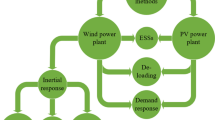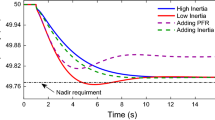Abstract
Recently, there have been growing attempts to replace conventional power generators with renewable energy sources. However, the inertia reduction that results from such measures jeopardizes the stability of the power system. Typically, power system operators utilize the spinning generating units to provide the required capacity to preserve system frequency where the carbon emission and wear/tear costs considerably affect their feasibility. Instead, this paper investigates the ability to use the existing assets (i.e., controllable demands) in providing the regulation needed to maintain the frequency within the allowable ranges. The proposed study reveals that the dynamically controlled space heaters were able to provide a fast primary response without a significant impact on the regular operation of the heaters. The proposed approach successfully reduced the conventional generator's regulating capacity during a sudden loss of generation/or a sudden increase in demand. Highlighting the impact of inertia reduction on the overall performance concludes the proposed study.









Similar content being viewed by others
Abbreviations
- C :
-
Heat capacity (kJ/kg K)
- D :
-
Percentage of frequency sensitive loads (%)
- E :
-
The energy in (MWh)
- H :
-
Generator inertia (s)
- K :
-
Lead-lag gain
- \(M_{{{\text{air}}}}\) :
-
Mass of air (kg/m3)
- \(M_{{{\text{dot}}}}\) :
-
Air mass flow (kg/h)
- \(P_{{\text{L}}}\) :
-
Load power (MW)
- \(P_{{\text{e}}}\) :
-
Electric power (MW)
- \(P_{{\text{m}}}\) :
-
Mechanical power (MW)
- \(P_{{\text{v}}}\) :
-
Valve power (MW)
- R :
-
Droop characteristic constant
- \(R_{{{\text{eq}}}}\) :
-
Building thermal resistance (k/W)
- \(T_{1}\) :
-
Lead-lag controller time constant (s)
- \(T_{2}\) :
-
Lead-lag controller time constant (s)
- \(T_{{\text{T}}}\) :
-
Turbine time constant (s)
- \(T_{{{\text{amb}}}}\) :
-
Ambient temperature F
- \(T_{{\text{g}}}\) :
-
Governor time constant (s)
- \(T_{{{\text{indoor}}}}\) :
-
Indoor temperature F
- \(T_{{{\text{in}}}}\) :
-
Temperature reference F
- \(T_{{{\text{room}}}}\) :
-
Room temperature F
- \(\frac{{{\text{d}}Q}}{{{\text{d}}t}}\) :
-
Heat flow
- \(\Delta f\) :
-
Frequency deviation in (p.u.)
- \({\Delta }T\) :
-
Temperature difference in F
- \(\Delta \omega\) :
-
Speed deviation in (p.u.)
References
Shafiullah, M.; Rana, M.J.; Abido, M.A.: Power system stability enhancement through optimal design of PSS employing PSO. In 2017 4th International Conference on Advances in Electrical Engineering (ICAEE), pp. 26–31 (2017). https://doi.org/10.1109/ICAEE.2017.8255321
Samarakoon, K.; Ekanayake, J.; Jenkins, N.: Investigation of domestic load control to provide primary frequency response using smart meters. IEEE Trans. Smart Grid 3(1), 282–292 (2012). https://doi.org/10.1109/TSG.2011.2173219
Akram, U.; Khalid, M.: A coordinated frequency regulation framework based on hybrid battery-ultracapacitor energy storage technologies. IEEE Access 6, 7310–7320 (2018). https://doi.org/10.1109/ACCESS.2017.2786283
Alam, A.; Abido, M.A.: Parameter optimization of shunt FACTS controllers for power system transient stability improvement. In: 2007 IEEE Lausanne Power Tech, pp. 2012–2017 (2007). https://doi.org/10.1109/PCT.2007.4538627
SEC: The Saudi Arabian Grid Code. Saudi Electricity Company (SEC), KSA, Issue 01, May 2007
ELSEVIER: Scopus—Document search. https://www-scopus-com.extoljp.kfupm.edu.sa/search/form.uri?display=basic. Accessed November 21, 2018
Tungadio, D.H.; Sun, Y.: Load frequency controllers considering renewable energy integration in power system. Energy Rep. 5, 436–453 (2019). https://doi.org/10.1016/j.egyr.2019.04.003
Rohit, A.K.; Devi, K.P.; Rangnekar, S.: An overview of energy storage and its importance in Indian renewable energy sector: part I—technologies and comparison. J. Energy Storage 13, 10–23 (2017). https://doi.org/10.1016/j.est.2017.06.005
Chen, H.; Cong, T.N.; Yang, W.; Tan, C.; Li, Y.; Ding, Y.: Progress in electrical energy storage system: a critical review. Prog. Nat. Sci. 19(3), 291–312 (2009). https://doi.org/10.1016/j.pnsc.2008.07.014
Gustavsson, J.: Energy storage technology. Energy Storage Symposium. Available http://adsabs.harvard.edu/abs/1976enst.symp...54L (1976)
Ramírez, M.; Castellanos, R.; Calderón, G.; Malik, O.: Placement and sizing of battery energy storage for primary frequency control in an isolated section of the Mexican power system. Electr. Power Syst. Res. 160, 142–150 (2018). https://doi.org/10.1016/j.epsr.2018.02.013
Cheng, M.; Sami, S.S.; Wu, J.: Benefits of using virtual energy storage system for power system frequency response. Appl. Energy 194, 376–385 (2017). https://doi.org/10.1016/j.apenergy.2016.06.113
Canevese, S.; Gatti, A.; Micolano, E.; Pellegrino, L.; Rapizza, M.: Battery energy storage systems for frequency regulation: simplified aging evaluation. In: 2017 6th International Conference on Clean Electrical Power (ICCEP), Santa Margherita Ligure, Italy, pp. 291–297 (2017). https://doi.org/10.1109/ICCEP.2017.8004830
Drysdale, B.; Wu, J.; Jenkins, N.: Flexible demand in the GB domestic electricity sector in 2030. Appl. Energy 139, 281–290 (2015). https://doi.org/10.1016/j.apenergy.2014.11.013
Bose, U.; Chattopadhyay, S.K.; Chakraborty, C.; Pal, B.: A novel method of frequency regulation in microgrid. IEEE Trans. Ind. Appl. 55(1), 111–121 (2019). https://doi.org/10.1109/TIA.2018.2866047
Delavari, A.; Kamwa, I.: Virtual inertia-based load modulation for power system primary frequency regulation (2018). https://doi.org/10.1109/PESGM.2017.8274601
Fang, J.; Li, H.; Tang, Y.; Blaabjerg, F.: Distributed power system virtual inertia implemented by grid-connected power converters. IEEE Trans. Power Electron. 33(10), 8488–8499 (2018). https://doi.org/10.1109/TPEL.2017.2785218
Fang, J.; Li, X.; Tang, Y.; Li, H.: Power management of virtual synchronous generators through using hybrid energy storage systems (2018). https://doi.org/10.1109/APEC.2018.8341201
Saeed Uz Zaman, M.; Bukhari, S.B.A.; Hazazi, K.M.; Haider, Z.M.; Haider, R.; Kim, C.-H.: Frequency response analysis of a single-area power system with a modified LFC model considering demand response and virtual inertia. Energies (2018). https://doi.org/10.3390/en11040787
Wu, D.; Guerrero, J.M.; Vasquez, J.C.; Dragicevic, T.; Tang, F.: Coordinated power control strategy based on primary-frequency-signaling for islanded microgrids (2013). https://doi.org/10.1109/ECCE.2013.6646817
Guruprasad, R.; Murali, P.; Krishnaswamy, D.; Kalyanaraman, S.: Coupling a small battery with a datacenter for frequency regulation. (2018). https://doi.org/10.1109/PESGM.2017.8274094
Avendano-Mora, M.; Camm, E.H.: Financial assessment of battery energy storage systems for frequency regulation service. In: 2015 IEEE Power Energy Society General Meeting (2015). https://doi.org/10.1109/PESGM.2015.7286504
Cheng, M.; Sami, S.S.; Wu, J.: Virtual energy storage system for smart grids. 88, 436–442 (2016). https://doi.org/10.1016/j.egypro.2016.06.021
Kim, Y.; Raghunathan, V.; Raghunathan, A.: Design and management of battery-supercapacitor hybrid electrical energy storage systems for regulation services. IEEE Trans. Multi-Scale Comput. Syst. 3(1), 12–24 (2017). https://doi.org/10.1109/TMSCS.2016.2627543
Lucas, A.; Chondrogiannis, S.: Smart grid energy storage controller for frequency regulation and peak shaving, using a vanadium redox flow battery. Int. J. Electr. Power Energy Syst. 80, 26–36 (2016). https://doi.org/10.1016/j.ijepes.2016.01.025
Morstyn, T.; Hredzak, B.; Agelidis, V.G.: Distributed cooperative control of microgrid storage. IEEE Trans. Power Syst. 30(5), 2780–2789 (2015). https://doi.org/10.1109/TPWRS.2014.2363874
Wang, R., et al.: A coordination control strategy of battery and virtual energy storage to smooth the micro-grid tie-line power fluctuations. Zhongguo Dianji Gongcheng XuebaoProceedings Chin Soc. Electr. Eng. 35(20), 5124–5134 (2015). https://doi.org/10.13334/j.0258-8013.pcsee.2015.20.002
Wu, J.; Hung, W.; Ekanayake, J.; Jenkins, N.; Coleman, T.; Cheng, M.: Primary frequency response in the great britain power system from dynamically controlled refrigerators. In: 22nd International Conference and Exhibition on Electricity Distribution (CIRED 2013), Stockholm, Sweden, pp. 0507–0507 (2013). https://doi.org/10.1049/cp.2013.0772
Short, J.A.; Infield, D.G.; Freris, L.L.: Stabilization of grid frequency through dynamic demand control. IEEE Trans. Power Syst. 22(3), 1284–1293 (2007). https://doi.org/10.1109/TPWRS.2007.901489
Cheng, M., et al.: Power system frequency response from the control of bitumen tanks. IEEE Trans. Power Syst. 31(3), 1769–1778 (2016). https://doi.org/10.1109/TPWRS.2015.2440336
Elamari, K.; Lopes, L.A.C.; Tonkoski, R.; Using electric water heaters (EWHs) for power balancing and frequency control in PV-diesel hybrid mini-grids, pp. 842–850 (2011). https://doi.org/10.3384/ecp11057842
Tokudome, M.; Tanaka, K.; Senjyu, T.; Yona, A.; Funabashi, T.; Kim, C.-H.: Frequency and voltage control of small power systems by decentralized controllable loads. In: 2009 International Conference on Power Electronics and Drive Systems (PEDS), Taipei, Taiwan, pp. 666–671 (2009). https://doi.org/10.1109/PEDS.2009.5385834
Cheng, M.; Wu, J.; Galsworthy, S.; Jenkins, N.; Hung, W.: Availability of load to provide frequency response in the great Britain power system. In: 2014 Power Systems Computation Conference, pp. 1–7 (2014). https://doi.org/10.1109/PSCC.2014.7038294
Yao, Y.; Zhang, P.; Wang, Y.: A two-layer control method for thermostatically controlled loads to provide fast frequency regulation. Zhongguo Dianji Gongcheng XuebaoProceedings Chin Soc. Electr. Eng. 38(17), 4987–4998 (2018). https://doi.org/10.13334/j.0258-8013.pcsee.171181
Yan, S.; Wang, M.-H.; Yang, T.-B.; Hui, S.Y.R.: Instantaneous frequency regulation of microgrids via power shedding of smart load and power limiting of renewable generation. Presented at the ECCE 2016—IEEE Energy Conversion Congress and Exposition, Proceedings (2016). https://doi.org/10.1109/ECCE.2016.7855207
Pourmousavi, S.A.; Nehrir, M.H.: Real-time central demand response for primary frequency regulation in microgrids. IEEE Trans. Smart Grid 3(4), 1988–1996 (2012). https://doi.org/10.1109/TSG.2012.2201964
Bharti, K.; Singh, V.P.; Singh, S.P.: Impact of intelligent demand response for load frequency control in smart grid perspective. IETE J. Res. (2020). https://doi.org/10.1080/03772063.2019.1709570
Jiang, I.; Ju, P.; Wang, C.; Li, H.; Liu, J.: Coordinated control of air-conditioning loads for system frequency regulation. IEEE Trans. Smart Grid, pp. 1–1 (2020). https://doi.org/10.1109/TSG.2020.3022010
Mendieta, W.; Cañizares, C.A.: Primary frequency control in isolated microgrids using thermostatically controllable loads. IEEE Trans. Smart Grid, pp. 1–1 (2020). https://doi.org/10.1109/TSG.2020.3012549
Liu, H.; Hu, Z.; Song, Y.; Wang, J.; Xie, X.: Vehicle-to-grid control for supplementary frequency regulation considering charging demands. IEEE Trans. Power Syst. 30(6), 3110–3119 (2015). https://doi.org/10.1109/TPWRS.2014.2382979
Malik, A.; Ravishankar, J.: A review of demand response techniques in smart grids. Presented at the 2016 IEEE Electrical Power and Energy Conference, EPEC 2016 (2016). https://doi.org/10.1109/EPEC.2016.7771745
Thornton, M.; Motalleb, M.; Smidt, H.; Branigan, J.; Siano, P.; Ghorbani, R.: Internet-of-things hardware-in-the-loop simulation architecture for providing frequency regulation with demand response. IEEE Trans. Ind. Inform. 14(11), 5020–5028 (2018). https://doi.org/10.1109/TII.2017.2782885
Obaid, Z.A.; Cipcigan, L.M.; Abrahim, L.; Muhssin, M.T.: Frequency control of future power systems: reviewing and evaluating challenges and new control methods. J. Mod. Power Syst. Clean Energy (2018). https://doi.org/10.1007/s40565-018-0441-1
Saadat, H.: Power Systems Analysis, 3rd edn. McGraw-Hill, New York (2010)
Balan, R.; Donca, R.; Balan, A.; Ple, A.: Thermal modelling and temperature control of a house. Romanian Rev. Precis. Mech. Opt. Mechatron. 39, 4 (2011)
Källblad, K.: Thermal models of buildings. lund Inst. Technol. 80 (1998)
Thavlov, A.; Bindner, H.W.: Thermal Models for Intelligent Heating of Buildings. Proc. Int. Conf. Appl. Energy ICAE, p. 11 (2012)
M. Donnelly, D.J.; Trudnowski, S. M., Dagle, J.E.: Autonomous demand response for primary frequency regulation. PNNL-21152, 1118120 (2012). https://doi.org/10.2172/1118120
Zeinali, M.; Thompson, J.S.: Practical evaluation of UK internet network characteristics for demand-side response applications. In: 2018 IEEE International Conference on Communications, Control, and Computing Technologies for Smart Grids (SmartGridComm), pp. 1–6 (2018). https://doi.org/10.1109/SmartGridComm.2018.8587541
Acknowledgments
The authors would like to acknowledge the support provided by King Fahd University of Petroleum & Minerals through the Direct Funded Project No. DF191004. Dr. Abido would also like to acknowledge the funding support provided by K.A. CARE Energy Research and Innovation Center (ERIC), KFUPM. The authors also acknowledge Qassim University for their continuous support.
Author information
Authors and Affiliations
Corresponding author
Appendix
Appendix
1.1 Key Parameters of the Power System Model
See Table 4.
1.2 Closed Loop Uncontrolled Matrix

1.3 Closed Loop Matrix with Lead-Lag Controller
Rights and permissions
About this article
Cite this article
Alotaibi, I.M., Abido, M.A. & Khalid, M. Primary Frequency Regulation by Demand Side Response. Arab J Sci Eng 46, 9627–9637 (2021). https://doi.org/10.1007/s13369-021-05440-x
Received:
Accepted:
Published:
Issue Date:
DOI: https://doi.org/10.1007/s13369-021-05440-x




